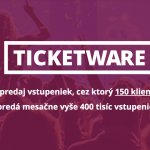The article discusses how we approach work with the public when organizing the Mazal Tov Festival of Jewish culture. The issue of development of a public is exceptionally complex; therefore, we focus mainly on questions associated with the festival’s programme makeup. The article links to the text “The Story of the Mazal Tov Festival”, in which the reader can learn more about our experiences from the past five years.
Culture and art play a major role in a society. They have the ability to educate, remove barriers, involve individuals and community, develop common social dialogues and improve the environment we live in. For a cultural organization it is important to thoroughly know your public, its expectations and needs and to approach it obligingly in terms of the programme and quality services but also the method of communication. Organizers should not forget children and young people; it should cultivate an interest in art in them, because in them we are educating our future visitors.
Care about the public and its development is for us – the organizers of the Mazal Tov Festival of Jewish Culture – one of the key factors influencing the programme composition, long-term planning, marketing, communication and the method of organizing the Mazal Tov Festival itself. Our path leads from an intuitive composition of the programme in the beginnings of the festival to a coherently exhibited conception, which places the visitor and his/her needs at the centre of interest. The first year of the festival, in 2012, we prepared only with existing experiences from our work up until then, without an exact idea about for whom the festival might be intended. We knew that we didn’t want to make it a closed event exclusively for members of the Jewish community; in contrast, our aim was to popularize Jewish culture and thus to present it to a broader public.
Join with the best
At the beginning we had a model to which we looked – the Festival of Jewish Culture in Krakow – the largest and most well known event of this type in the world. That festival, each year offering more than 300 events over tens of days and which is attended by 30,000 visitors from around the world, is for us still an unreachable goal, but its programme quality remains a continuous inspiration. Before we began to plan specifically the first year of Mazal Tov, we met with the director of the Krakow festival, Janusz Makuch. Janusz expressed support for our aim and also helped on the practical side of things. He arranged for us in the first year of the festival two resonant names – Frank London, a member of the famous group the Klezmatics, and the brilliant jazz saxophonist Paul Shapiro from the formation Midnight Minjan. So that we were not simply copying anyone, we prepared an original programme with these musicians – we appealed to them to cooperate with Slovak groups. These combinations brought a unique, unrepeatable artistic experience. Aside from these two main concerts we also added to the festival a literary-musical evening, an exhibition and a lecture on Jewish personalities of Košice, a musical and dance workshop, a creative workshop for children and a guided tour of Jewish monuments of Košice. The pilot year had excellent attendance and enthusiastic responses from both the lay and expert public.
Know your public
We approached the second year of our event with the bar set high and great expectations. This is still the largest year of the festival, in regards to number of events, attendance and budget. This was associated with the fact that in 2013 Košice was a European Capital of Culture, and it was expected that festival on this occasion would build a grandiose programme on a worldwide level. This expectation was met.
Even then, however, we thought about in which direction Mazal Tov should move forward. During the festival we carried out a questionnaire survey with visitors. We needed to obtain as much information as possible about our public, so that we could plan the subsequent activities responsibly. From the survey and other information, it followed that we need to focus on obtaining the interest of the young generation (to 24 years), because this group was poorly represented in the public.
To sustain the existing public and to obtain a new one
Two groups of the public always exist. The first of them is the public we already have. This public knows our festival and has attended it at least once. For this group we focused activities that build community, a strong relationship and personal interest in our activities. One of them was an informal artistic-educational event Being a Jew. We organized it in April 2015, outside of the festival dates, and we sent out invitations to people who had subscribed to the festival newsletter. Participants had the opportunity in the course of a whole day to attend the Košice synagogue free of charge to hear lectures on Jewish customs, enjoy traditional music and foods and at the end to also honour a monument to victims of the Holocaust. This was a space for informal discussions and more thorough discovery of Jewish history and culture, which enabled the deepening of the relations visitors have to our organization and our activities.
The second group is the potential public, which thus far doesn’t know of the Mazal Tov Festival. Since at present people have a great amount of leisure-time activities to choose from, it is not enough to only introduce them to our activities; we have to convince them as the potential public that our production is just the thing to interest them.
We clearly needed to determine the target group we wanted to address so as not to waste time, finances and energy. We decided to concentrate on the generation of young adults (age 18 – 24 years) who attend cultural events in Košice and also on children of preschool and younger school age.
Therefore, we began to focus the festival programme for the following years more conspicuously on contemporary creation with the potential to address the target group. We preserved proven genres in the programme, for example, klezmer music, but we offer it in an innovative, less traditional form. In general, in the course of five years we have shifted from known names to the discovery of new and fresh art currently originating in Israel and in Europe. We have gradually expanded the programme offer with films, comics or puppet theatre for children. We also adapted the location – we organized events in places where the community of young people gather, where they go for culture.
These changes were not immediately reflected in the makeup of the public, and we didn’t expect them to be. The average age of the festival visitors, however, did gradually drop.
Very briefly about marketing
An independent article could be written about branding, marketing and PR of the festival. We will at least mention the fact that after three years we changed the logo and design of the visual communication of the festival. The original logo, which originated in a hurry, depicted in symbols the head of a Jewish man with a yarmulke. With time, however, we became aware that we want to avoid this stereotype. The basis of the new logo and design became the triangle, as the basic element of the Jewish “Star of David”; this reference, however, is not primary.
In the course of five years we significantly reduced the original large volumes of analog printed ads (posters, citylights, flyers) and today our main communication medium is Facebook. On social networks we can adapt to both types of public – those we already have coalesce into a community and build solidarity with the festival, and the potential public is then more easily reachable thanks to the existing connection to networks. Social networks are also a possible instrument for obtaining feedback and opinions from the public. We also inform about the festival in mass media, print and digital dailies – these means have been proven to be effective according to our surveys.
Development of the public is a continual actively managed process through which we support each of our visitors and each potential visitor in a connection of trust. It is not always easy to gain trust; therefore we try not to disappoint the visitors to the Mazal Tov Festival. Not only are the programme and artistic production of the festival itself important but also the quality of organization, the comfort provided, the easy access to information and a human approach.









Add Comment